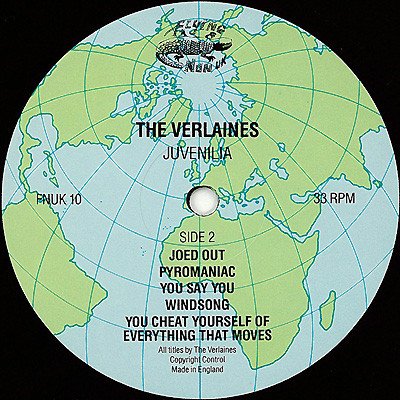Dunedin Sound
The Dunedin Sound represented the undervalued cultural vibrancy of a remote yet sublime city.
Juvenilia, The Verlaines: Flying Nun Records
Boodle Boodle Boodle, The Clean: Chris Knox
Kaleidoscope World, The Chills: Martin Phillipps
Dunedin (Ōtepoti in Te Reo Māori) is a beautiful small city at the arse-end of New Zealand, itself a beautiful country at the arse-end of the world. New Zealand is often overlooked internationally — so much so that it is routinely excluded from world maps by accident. Yet this small, underappreciated city in the southern corner of such a country managed to produce a vibrant and internationally influential music scene during the 1980s and into the 1990s — the Dunedin Sound.
Dunedin today sits in a grey area between town and city with a population of 128,000 people settled around the spectacular Otago peninsula. It is the kind of place where one can look up from the high street and see sheep paddocks sprawled across green, rolling hills in the near distance. It is a gothic city: its suburbs spread across steep streets often shrouded in drizzle, complete with stunning Edwardian, Victorian and neo-Gothic architecture.
Yet Dunedin is no sleepy rural city — this is a university town, infamous for riotous street parties and a vibrant student culture centred around Otago University. Couch burning and the riot squad are phrases associated with invariably debauched parties on Castle Street, a wide, treeless thoroughfare populated by personalised student houses. However, Dunedin nightlife is not restricted to purely outdoor affairs — the city today punches well above its weight with its thriving bar and nightclub scene.
A similar combination of gothic geography and raucous cultural life produced the Dunedin Sound of the 1980s. Dunedin local Shiree Gwynne recalls “lots of venues to see gigs and lots of parties to go to after.”:
“My friends and I frequented the Dunedin Musicians Club, which, a lot of the time, was local muso’s playing with their bands or just hav[ing] jam sessions. […] There were many other venues as well.”
This included The Empire Tavern, built in 1858 and recognised as the launchpad of the Dunedin Sound.
“The Empire had three floors of bars. All three bars were obviously old and atmospheric. The bottom bar often had solo and acoustic musos playing [...] up the stairs [was] the pool bar; [...] often frequented by Dunedin’s gang the Mongrel mob. Pretty relaxed though, from what I remember.”
Finally, there was the third-floor “band bar” which was “Intimate and fun, almost like being in someone’s lounge.” Altogether, it was “a great venue for bands, including [...] the Clean, the Verlaines and the Chills.”
Gwynne concluded that “The vibe of Dunedin was great. It felt like a hub for nurturing independent music and the arts.” The Dunedin Sound was the jangly core of this independent music scene. Championed by New Zealand’s own Flying Nun Records, bands like the Clean, the Verlaines and the Chills emerged in the late 1970s, coalescing into a thriving scene around 1982.
The Dunedin Sound is instantly recognisable: many of the bands carry a combination of influences from the 1960s — notably the proto-punk of the Stooges and the Velvet Underground — modulated by the splendid isolation of the city and, according to The Chills’ Martin Phillipps, its “cold, drizzly atmosphere”. Altogether, this produced a unique, moody lo-fi sound with significant psychedelic qualities. The Dunedin Sound, filtering into US college radio stations, would be a key influence for significant American bands like Pavement, Mudhoney and REM.
Juvenilia, The Verlaines: Flying Nun Records
Tracks like the Chills’ ‘Pink Frost’ (1984) exemplify the Dunedin Sound: the piece is driven by a jangly, droning riff that together with an unconventional, deadpan delivery of desperate lyrics produces a haunting, melancholic sound that evokes Dunedin so well. The Clean’s ‘Point That Thing Somewhere Else’ (1981) takes a more psychedelic angle to produce a similar vibe, with soft yet punk-ish vocals set to a roving, dissonant guitar line.
The Verlaines’ ‘Death and the Maiden’ (1983) also carries the gothic theme, combined with classical influences and literary references to poet Paul Verlaine (the founding member of the band, Graeme Downes, would later lead the music department of the University of Otago.) ‘Cactus Cat’ (1986), by Look Blue Go Purple, represents a more whimsical side of the scene and relies on a simple riff to deliver a love letter to a cat that sits somewhere between jubilant and melancholic.
Finally, it would be remiss to omit mention of the Bats (who formed in Christchurch but are so connected to Dunedin that the band is considered a part of the Dunedin Sound) – lead by former bassist of the Clean Robert Scott – and their song ‘Made Up In Blue’ (1986), which epitomises the wistful jangle of the scene, along with a growling bassline that conflicts with Scott’s higher, forlorn vocals.
Altogether, the Dunedin Sound represented the undervalued cultural vibrancy of a remote yet sublime city. Most strikingly to me, the sound of the scene impeccably evokes Dunedin as a place: a melancholic melange of depressed, moody beauty and boisterous cultural life; a certain darkness given a softer edge by a warm heart.





